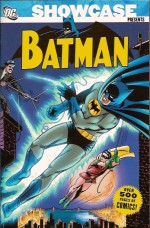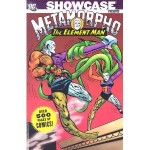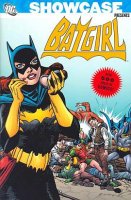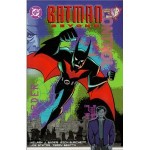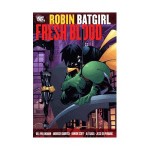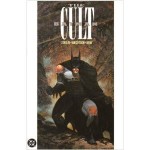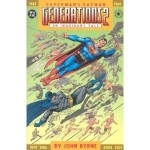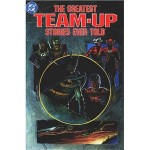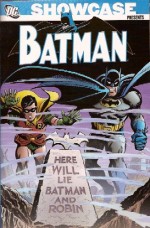New revised review
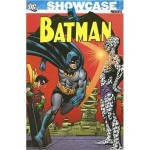
By Gardner Fox, John Broome, Robert Kanigher, Sheldon Moldoff, Carmine Infantino & various (DC Comics)
ISBN 978-1-84576-661-0
This volume from the wonderfully cheap and cheerful Showcase Presents… imprint serves up all thirty-six new Batman stories from September 1965 to December 1966 (which originally appeared in Batman #175-188 and Detective Comics #343-358 – excluding Batman’s #176, 182, 185 & 187 which were all-reprint 80-Page Giants) in beautiful, crisp black and white. They were produced in the months leading up to the launch of and throughout the first year of the blockbuster Batman television show (premiering on January 12th 1966 and running for three seasons of 120 episodes in total).
The show aired twice weekly for its first two seasons, resulting in vast amount of Bat-awareness, no end of spin-offs and merchandise – including a movie – and the overkill phenomenon of “Batmaniaâ€. No matter how much we might squeal and foam about it, to a huge portion of this planet’s population Batman is always going to be that “Zap! Biff! Pow!†buffoonish costumed Boy Scout…
Regrettably this means that the comic stories published during that period have been similarly excoriated and maligned by most Bat-fans ever since. It is true that some tales were crafted with overtones of the “camp†fad, presumably to accommodate newer readers seduced by the arch silliness and coy irony of the show, but no editor of Julius Schwartz’s calibre would ever deviate far from the characterisation that had sustained Batman for nearly thirty years, or the then-recent re-launch which had revitalised the character sufficiently for television to take an interest at all.
Nor would such brilliant writers as John Broome, Bill Finger, Gardner Fox and Robert Kanigher ever produce work which didn’t resonate on all the Batman’s intricate levels just for a quick laugh and a cheap thrill. The artists tasked with sustaining the visual intensity included such greats as Carmine Infantino, Sheldon Moldoff, Chic Stone, Joe Giella, Murphy Anderson and Sid Greene, with covers from Gil Kane and Joe Kubert supplementing the stunning and trend-setting, fine-line Infantino masterpieces.
Most of the stories in this compendium reflect those gentler times and editorial policy of focusing on Batman’s reputation as “The World’s Greatest Detectiveâ€, so the colourful, psychotic veteran costumed super-villains are still in a minority here, but there are first appearances for a number of exotic foes who would become regular menaces for the Dynamic Duo in years to come.
The mayhem and mystery begin with a book-length epic from Detective Comics #343 (September 1965) by John Broome, Carmine Infantino & Joe Giella, incorporating back up feature Elongated Man (a costumed sleuth who blended the charm of Nick “Thin Man†Charles with the outré heroic antics of Plastic Man) in ‘The Secret War of the Phantom General!’
This tense thriller pitted the hard-pressed heroes against a hidden army of gangsters and Nazi war criminals, whilst #344 introduced intellectual bandit Johnny Witts, ‘The Crime-Boss who was Always One Step Ahead of Batman!’ in a sharp duel of mentalities from Gardner Fox, Sheldon Moldoff & Giella.
The same creative team produced the epic shocker ‘The Decline and Fall of Batman’ in the 175th issue of his own titular magazine wherein fringe scientist Eddie Repp almost ended the Caped Crusaders’ careers by assaulting them with electronic ghosts, after which Detective #345 introduced a terrifying, tragic new villain in ‘The Blockbuster Invasion of Gotham City!’ (Fox, Infantino & Giella) as a monstrous giant with the mind of a child and the raw, physical power of a tank was constantly driven to madness at sight of Batman and only placated by the sight of Bruce Wayne…
Batman #177 opened with a Bill Finger, Moldoff & Giella puzzler, ‘Two Batmen Too Many’ complete with a pair of superhero guest-stars, after which ‘The Art Gallery of Rogues!’ by Broome, Moldoff & Sid Greene combined good-natured matchmaking with murderous burglary whilst ‘Batman’s Inescapable Doom-Trap!’ (Detective #346, Broome, Moldoff & Giella) highlighted the Caped Crimebuster’s escapology skills when a magician-turned-thief alpha-tested his latest stunt on the unwilling, unwitting hero.
‘The Strange Death of Batman!’ by Fox, Infantino & Giella in Detective # 347 saw the debut of habitual B-list villain the Bouncer in a bizarre experimental yarn which has to seen to be believed, whereas it was business as usual in the all-action Batman #178 where the ‘Raid of the Rocketeers!’ (Robert Kanigher, Moldoff & Giella) set the Gotham Gangbusters on the trail of jet-packed super-thugs whilst Broome, Moldoff & Greene began referencing the tone of the TV series in the light-hearted crime-caper ‘The Loan Shark’s Hidden Horde!’
Whilst ‘The Birdmaster of Bedlam!’, who hatched his first sinister scheme in Detective #349 (Kanigher, Moldoff & Giella) proved ultimately incapable of containing the Caped Crusaders, Batman #179 provided more of a challenge with ‘Clay Pigeon for a Killer!’ (Kanigher, Moldoff & Greene – erroneously credited as Giella here) finding Batman using a television “Most Wanted†show to trap a murderer beyond the reach of the law and ‘The Riddle-less Robberies of the Riddler!’ by Broome Moldoff & Giella, fully recreating the modern Prince of Puzzlers. The felon discovered he could not escape or defy the obsessive psychological compulsion which prevented him from committing crimes unless he sent clues to Batman, but sadly even when Eddie Nigma cheated, the Masked Manhunter kept solving the riddles…
The microcephalic man-brute who hated Batman returned when ‘The Blockbuster Breaks Loose!’ in a blistering, action-fuelled thriller by Fox, Infantino & Giella (Detective #349) which also hinted at the return of a long-forgotten foe, whilst ‘The Monarch of Menace!’ from #350 (Kanigher, Moldoff & Giella), introduced the greatest criminal in the world, who started well but inevitably fell to the Gotham Gangbuster’s indomitable persistence.
Batman #180 introduced the uncanny Death-Man in ‘Death Knocks Three Times!’ Kanigher’s best tale of this era and an early indication of the Caped Crusaders eerie potential (illustrated by Moldoff & Giella) after which Detective #351 premiered game-show host turned felonious impresario Arthur Brown in ‘The Cluemaster’s Topsy-Turvy Crimes!’ by Fox, Infantino & Greene.
‘Beware of… Poison Ivy!’ in Batman #181 introduced the deadly damsel to the Caped Crusader’s Rogues Gallery, but in this tale she was a mere criminal boss using sex as her weapon to split up the Dynamic Duo and defeat rival villainess in a sly tale from Kanigher, Moldoff & Giella. Following a spiffy, iconic pin-up courtesy of Infantino & Murphy Anderson comes a superb Mystery Analysts of Gotham City shocker ‘The Perfect Crime… Slightly Imperfect!’, by Fox, Moldoff & Greene whilst Detective #352 featured Broome, Moldoff & Giella’s ‘Batman’s Crime Hunt A-Go-Go!’, wherein the Gotham Guardian hit an incredible hot-streak, repeatedly catching criminals in the act with incredible lucky hunches. Of course, there’s no such thing as luck and sinister stage mentalist Mr. Esper was manipulating the crime-busting campaign for his own sinister ends…
After another stunning Infantino & Anderson Batman pin-up the action continues with ‘The Weather Wizard’s Triple-Treasure Thefts!’ (Fox, Infantino & Giella) in #353 which pitted the Dynamic Duo in spectacular opposition to the Flash’s arch enemy: one of the first times a DC villain moved out of his usually stamping grounds. Batman #183 opened with ‘A Touch of Poison Ivy‘ (Kanigher, Moldoff & Giella) as the seductive siren tried once again to turn the Caped Crusader’s head before the excellent “fair-play†mystery ‘Batman’s Baffling Turnabout!’ saw Gardner Fox challenge the readers to deduce what could turn the hero against a bewildered Boy Wonder…
‘No Exit for Batman’ (Detective #354, by Broome Moldoff & Giella) introduced bloodthirsty oriental fiend Dr. Tzin-Tzin in a bruising all-action tale, before Fox’s ‘Mystery of the Missing Manhunters!’ generated one of the most memorable covers of the decade for Batman #184 and the back-up Robin solo tale ‘The Boy Wonder’s Boo-Boo Patrol!’ (Fox, Chic Stone & Sid Greene) showed the lad’s sheer potential in a clever tale of thespian skulduggery and smart conundrum solving.
Detective #355 once more highlighted our hero’s physical prowess as well as deductive capabilities in the blistering ‘Hate of the Hooded Hangman!’ (Broome, Infantino & Giella), after which the extended duel with a mutant mastermind culminated in ‘The Inside story of the Outsider!’ and the resurrection of faithful retainer Alfred in a classic confrontation by Fox, Moldoff & Giella from Detective Comics #356.
Batman #186 featured the Clown Prince of Crime in possibly his most innocuous exploit ‘The Joker’s Original Robberies’ as Broome, Moldoff & Giella, tried to out-Camp the TV show, but ‘Commissioner Gordon’s Death-Threat!’ (written by Fox) put the artists’ talents to far better use in a terse and compelling kidnap thriller. Broome redeemed himself in Detective #357 with the clever secret identity saving puzzler ‘Bruce Wayne Unmasks Batman!’ (Infantino & Giella).
Batman #188 featured ‘The Eraser Who Tried to Rub Out Batman!’ (Broome, Moldoff & Giella) and the decidedly sharper and less silly murder-mystery ‘The Ten Best-Dressed Corpses in Gotham City!’ by Fox, Moldoff & Greene after which this collection concludes on a note of psychological intrigue as Detective #358 described ‘The Circle of Terror’ (Broome, Moldoff & Giella) wherein the Masked Manhunter was progressively driven to the edge of madness by Op Art maestro the Spellbinder.
With covers by Infantino, Gil Kane, Murphy Anderson and Joe Kubert, pin-up extras, frequent reprint compendiums and lots of cross-pollination with the TV series, DC were pulling out all the stops to capitalise on the screen exposure and ensure the comic buying public got their 12¢ worth, but the most effective tool in the arsenal was always the sheer variety of the stories.
The bulk of the yarns reprinted here are thefts, capers and sinister schemes by heist men, murderers, would-be world-conquerors and mad scientists and I must say it is a joy to see these once-common staples of comic books in action again. You can have too much psycho-killing, I say, and just how many alien races really and truly can be bothered with our poxy planet – or our women?
And yes, there are one or two utterly daft escapades included here, but overall this book is a magical window onto a simpler time but not burdened by simpler fare. These Batman adventures are tense, thrilling, engrossing, engaging and even amusing and I’d have no qualms giving them to my niece or my granny.
Tune and become a proper Bat-fan.
© 1965, 1966, 2007 DC Comics. All Rights Reserved.

